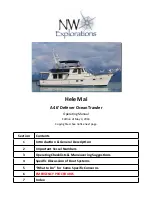
1-10
E
●
Both operator and passengers must
always wear a U.S. Coast Guard
approved personal flotation device (vest-
type) because of the drowning hazards
associated with water sports.
1
U.S. Coast Guard-approved personal flotation
device
2
Wet suit
3
Water shoes
4
Gloves
5
Eye protection
●
Strong streams of water from the jet noz-
zle, or impact with the water surface can
be dangerous. Both operator and passen-
gers must wear wet suits. Normal swim-
ming attire may not adequately protect
you. A wet suit will help protect against
internal injuries to orifices (rectum and
vagina) from strong jet streams, and from
impact with the water surface. Wet suits
also help protect against hypothermia
(low body temperature) and abrasions.
●
Both operator and passengers should
wear water shoes to help protect feet from
objects hidden under water. Wearing
gloves can also help protect hands from
abrasions.
●
Wind, water, and glare from the sun may
get in your eyes while you operate your
water vehicle, reducing your ability to see.
You may want to consider wearing eye
protection such as sunglasses or goggles
while riding. Some may find, however,
that eye protection obstructs or distorts
their vision, and distracts from operation.
Only you know the circumstances in
which you operate your water vehicle, so
only you can decide if the benefits of eye
protection outweigh the potential hazards.
●
If you wear prescription lenses, consider
measures to secure them against loss
while riding. For example, some goggles
are designed to be worn over glasses or
contact lenses. Restraining straps for
glasses are also made which are
designed to float if your glasses should
fall in the water.
●
Helmets meeting Snell or DOT standards
are required for IJSBA-sanctioned races.
You must decide whether to wear a hel-
met while you ride recreationally. A hel-
met could help protect you in certain
kinds of accidents. You should also know
that a helmet could injure you in some
other riding conditions.
A helmet is designed to provide some
head protection. Although helmets cannot
protect against all foreseeable impacts, a
helmet might reduce your injuries in a col-
lision with a boat or other obstacles.
A helmet may have potential safety haz-
ards, as well. A helmet could catch the
water during a fall into the water. This is
commonly called “bucketing.” The result-
ing strain on your neck could cause chok-
ing, severe and permanent neck injuries,
or death. A helmet could also increase
the risk of an accident if it reduces your
vision or hearing, or if it distracts you or
increases your fatigue.
Summary of Contents for XA1200Ltd WaveRunner
Page 7: ...1 3 E EJU00293 IMPORTANT LABELS LOCATION ...
Page 8: ...1 4 E LABELS Warning labels 1 2 4 5 6 3 ...
Page 9: ...1 5 E 7 8 9 A B ...
Page 10: ...1 6 E Caution labels C D E F G I H ...
Page 11: ...1 7 E Other labels J K L ...
Page 25: ...E MEMO ...
Page 103: ...4 17 E Shift cable lever side Shift cable reverse gate side YPVS cable ...
Page 118: ...E 6 EJU00608 Chapter 6 INDEX INDEX 6 1 ...
Page 122: ...E MEMO ...















































